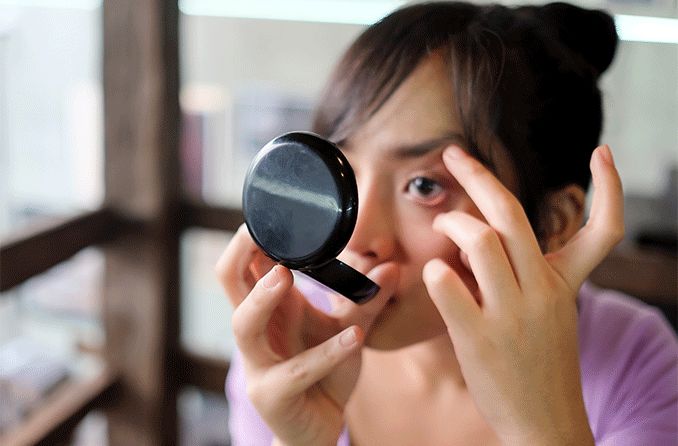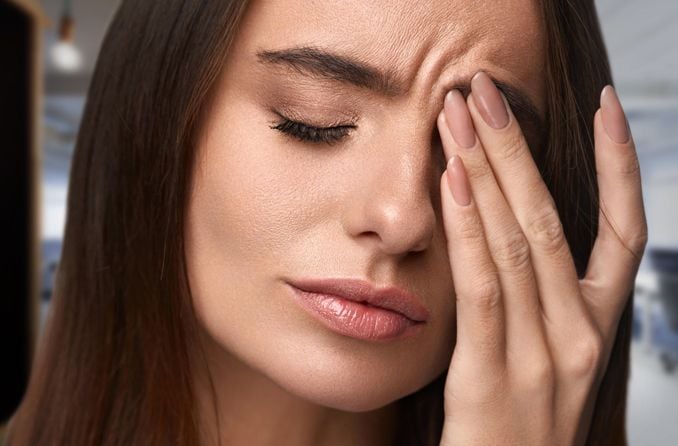Getting debris in your eye is an unpleasant, uncomfortable experience, albeit a common one. Most people will go through this at some point in their lives — if this happens to you, you’ll want to know how to get that foreign body out of your eye as quickly and safely as possible.
Learning more about the right tools to have on hand, as well as some recommended techniques (eye movement, flushing out the eye with saline drops, etc.), will go a long way toward helping you remove foreign objects and regain a sense of comfort.
How to get something out of your eye: Useful tools
There are a few basic techniques to keep in mind when you are trying to get something out of your eye, whether that object is visible or invisible. But first, you’ll want to have some household items and commercial products (such as eye drops) ready. These will make up your toolkit and help speed up the process of removing particles from your eye.
Get your toolkit ready
It may sound challenging to prepare yourself when you’re under stress and experiencing discomfort, but having some (or all) of these tools on hand can help you remove an object from your eye:
Clean, dry hands (use soap and water and ensure that you dry your hands with a fluff-free cloth to avoid getting more foreign objects in your eye).
A cotton swab moistened with saline solution or eye drops (a clean, fluff-free, moistened cloth is also acceptable).
A mirror.
Bright lighting (preferably natural light if you need help during the day).
An eye wash cup.
Saline solution or eye drops.
A friend (if one is available) to assist you.
Any one of these can help you get rid of that pesky debris in your eye, but having someone assist you can certainly make things a bit less difficult.
How to remove a visible object from your your eye
It is easier to remove something from your eye if you can see it. Start by standing in front of a mirror in a brightly lit area. Gently use your thumb and forefinger to open the affected eye slightly.
Place your forefinger on your brow line and your thumb just beneath your lower eyelid to stretch your eye open a bit. This will give you a better look at your eye, helping you to identify whether the debris is on your cornea (the clear front surface of the eyeball, located in front of the iris and pupil ) or the sclera. The sclera is the white part of the eye.
The idea is to be able to see the particle on your eye so that you can remove it. Once you see it, take the swab and gently touch it to the object for removal.
Many people are extremely sensitive about anything being near their eyes, though, and may close their eyes instinctively when trying this method. In cases like this, it may be best to call a friend for help.
Another option is to use eye drops or saline solution to drip into the open eye. Adding moisture helps to make your eyes water more. Producing tears may create enough liquid to blink the object out of your eye naturally.
Use one or more of these methods to remove a visible object on the surface of your eye. Most of these methods can also be helpful in removing things you can’t see on the eye's surface.
How to get something out of your upper eyelid
When something is stuck under your upper eyelid, gently stretch the upper eyelid over the lower lid, then rotate your eyes to try and dislodge the debris. You can also move your eyes sideways if rotating them doesn't work.
Your eye movements will help move the object to a visible place on your eye. Once you see what’s irritating your eye, you can follow any of the above-mentioned methods to remove it.
Eye wash cups, which you can find at most drugstores, are also a handy way to rinse items out of the eyes. Place the indicated end of the cup over the entire eye. Ensure that you are reasonably comfortable filling the cup with an eye-safe solution or eye drops before rinsing out any foreign items.
If you don’t already have an eye wash cup, be sure to add it to your shopping list so you’ll have one ready if you need it in the future.
How to remove an object stuck under the lower eyelid
Getting rid of debris hiding under the lower eyelid involves similar actions as the methods above.
You’ll want to start by placing your finger on the skin below your lower eyelid and (cautiously) stretching downward. Then, look downward while rapidly releasing the lower eyelid from its stretched position. Repeat this until you can eject the foreign matter.
If you don’t get the desired results with this, you can try the other listed techniques, including:
Using eye drops to rinse your eye.
Flushing your eyes with an eye wash cup.
Need to know how to get something out of the corner of your eye? You can try any of these methods for that scenario too. Just keep in mind that it is essential to move your eyes and blink while rinsing with saline solution or eye drops.
The “don’ts” of how to get something stuck out of your eye
Your eyesight is one of your most critical senses when moving around in the world. If your vision is blurred or damaged, life can become more challenging. Therefore, it’s important to always protect your eyes and your vision — even if you’re just removing a very tiny object from your eye.
When it comes to getting debris out of your eye, there are definitely some things you should never do , as they can cause damage or lead to infection.
Do not use tap water to rinse your eyes.
Don't use your finger to remove an object from your eye.
Avoid bringing your hands to your face unless you have disinfected them.
Do not rub your eyes, as this can potentially lead to a corneal abrasion (scratched eye).
Don’t panic. Try to get to a state of calm, where you will be comfortable resolving the situation.
Do not drive if your vision is too severely impaired.
Always exercise caution and always wash your hands first when you need to remove something from your eye. This will help you to avoid unpleasant infections, including conjunctivitis (pink eye), styes and keratitis.
Of course, eye infections can develop regardless of the state of your hands, but there is still a higher risk when your hands are dirty — make hand-washing a priority to safeguard your vision.
SEE RELATED : What happens if you get glitter makeup in your eye?
When to seek medical assistance
If none of your efforts to remove debris from your eye work out, it’s time to consult an expert. Medical assistance is advisable when:
You feel uncomfortable and suspect that the object is still in your eye.
Redness in the eye doesn’t seem to be improving after several hours.
Your eye feels like it has tears or scratches on the surface that don’t seem to be improving.
Eye inflammation develops.
Your vision is negatively impacted.
While it’s common for the eye to remain red for some time after removing a foreign object, it is not normal for the redness to stay longer than a few hours. If it does, visit an eye doctor who can examine you and offer some relief.
Similarly, if you’re experiencing pain after a few hours (or if the pain is getting worse), a medical doctor or optometrist can help.
READ NEXT: It feels like something is in my eye









